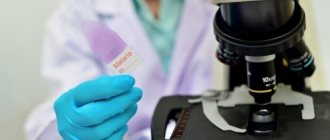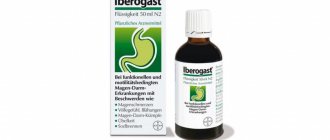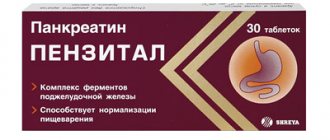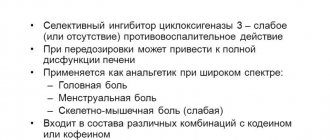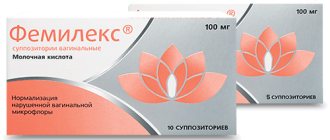Release form, packaging and composition of the drug Clinical-pharmacological group Pharmaco-therapeutic group Pharmacological action Indications for use Method of administration and doses Side effects Contraindications for use Use in children Special instructions Drug interactions
Registration Certificate Holder:
KRKA-RUS, LLC (Russia)
ATX Code:
C01DA02
Active substance:
nitroglycerin (glyceryl trinitrate)
Dosage form:
Sustak Forte
| The drug is available with a prescription | Sustak Forte | Tab. prolong. action 6.4 mg: 25 pcs. reg. No.: P N011909/01 dated 03.11.06 - Valid |
pharmachologic effect
Peripheral vasodilator with a predominant effect on venous vessels. Antianginal agent. The mechanism of action is associated with the release of the active substance nitric oxide in the smooth muscles of blood vessels. Nitric oxide causes activation of guanylate cyclase and increases cGMP levels, which ultimately leads to smooth muscle relaxation. Under the influence of glyceryl trinitrate, arterioles and precapillary sphincters relax to a lesser extent than large arteries and veins. This is partly due to reflex reactions, as well as the less intense formation of nitric oxide from active substance molecules in the walls of arterioles.
The effect of nitroglycerin (glyceryl trinitrate) is mainly associated with a decrease in myocardial oxygen demand due to a decrease in preload (dilation of peripheral veins and a decrease in blood flow to the right atrium) and afterload (decreased OPSS). Promotes the redistribution of coronary blood flow into ischemic subendocardial areas of the myocardium. Increases exercise tolerance in patients with coronary artery disease and angina pectoris. In heart failure, it helps to unload the myocardium mainly by reducing preload. Reduces pressure in the pulmonary circulation.
Special instructions for the use of the drug Sustak
Use with extreme caution in patients with severe anemia, hypoxemia, cor pulmonale, dehydration and mitral valve prolapse, liver dysfunction, hypothyroidism, hypothermia and cachexia. Headache is most pronounced at the beginning of treatment with the drug. Sudden discontinuation of the drug may worsen the course of coronary artery disease. When treating with Sustak Forte, you should adhere to a 12-hour interdose interval to prevent the development of tolerance to the drug. Cross-tolerance to other nitrates and nitrites is possible. Safety of use in children has not been established. During pregnancy, the drug is prescribed only when the expected therapeutic effect for the expectant mother outweighs the potential risk to the fetus. During treatment with the drug, it is recommended to stop breastfeeding. Nitroglycerin may negatively affect the ability to drive vehicles and operate potentially dangerous machinery.
Indications for use
For sublingual and buccal use: relief and prevention of angina attacks; as an emergency medicine for acute myocardial infarction and acute left ventricular failure at the prehospital stage.
For oral administration: relief and prevention of angina attacks, rehabilitation treatment after myocardial infarction.
For intravenous administration: acute myocardial infarction, incl. complicated by acute left ventricular failure; unstable angina; pulmonary edema.
For cutaneous use: prevention of angina attacks.
Directions for use and doses
The method of administration and dosage regimen of a particular drug depend on its release form and other factors. The optimal dosage regimen is determined by the doctor. The compliance of the dosage form of a particular drug with the indications for use and dosage regimen should be strictly observed.
Use sublingually, buccally, orally, cutaneously, intravenously. The dose and treatment regimen are set individually, depending on the indications, the specific clinical situation, and the dosage form used.
Sustak
Orally, sublingually, buccally, intravenously, transdermally, cutaneously.
Relief of angina pectoris. Sublingually (the tablet or capsule is kept under the tongue until completely absorbed, without swallowing), immediately after the onset of pain - 0.5-1 mg per dose. If necessary, to achieve a faster effect, the capsule should be immediately crushed with teeth; the capsule can be repeated after 30-40 minutes. In many patients with stable angina, the effect occurs with a smaller dose (1/2-1/3 tablets), therefore, if the pain goes away quickly, it is recommended to spit out the remainder of the tablet that has not had time to dissolve. Typically, the antianginal effect appears within 0.5-2 minutes; 75% of patients note improvement within the first 3 minutes, and another 15% within 4-5 minutes. If there is no antianginal effect, another 0.5 mg of nitroglycerin should be taken during the first 5 minutes. If there is no therapeutic effect after taking 2-3 tablets, you should immediately call a doctor. Duration of action after sublingual administration is about 45 minutes.
For frequent attacks of angina, it is advisable to prescribe prolonged forms of nitrates. If an angina attack develops during treatment with long-acting nitrates, nitroglycerin must be taken sublingually to stop the acute attack. Tolerance to sublingual forms of nitroglycerin develops infrequently, however, if it occurs in some patients, the dose of the drug must be gradually increased, bringing it to 2-3 tablets.
To prevent angina pectoris, take it orally with water before meals. In mild cases - 1-2 tablets of 2.9 mg 2-3 times a day. In more severe cases - 1-2 tablets of 5.2 mg 2-3 times a day. The maximum daily dose is 34.8 mg. Due to the fact that the bioavailability of nitroglycerin from retard tablets is low, it is recommended, if well tolerated, to take 1-3 tablets at a time regularly 3-4 times a day or periodically, 30-40 minutes before the expected physical activity. If the therapeutic effect is insufficient, the dose can be gradually increased (but not more than 2 tablets per dose), and after the onset of a therapeutic effect, it can be reduced.
1% solution for sublingual use: relief of an attack - 1-2 drops sublingually or 2-3 drops applied to a small piece of sugar and keep it in the mouth, without swallowing, until completely absorbed.
Buccal: a plate with a selected dose of nitroglycerin is glued to the oral mucosa, usually in the upper gum area above the canines or small molars. To do this, simply press the plate with your finger against the oral mucosa for a few seconds. The action occurs almost immediately and lasts 3-4 hours or more.
Transdermal: treatment begins with the application of one TTC 5 patch (0.2 mg/h) per day. To maintain therapy, the daily dose can be increased by attaching an additional patch (0.2 mg/h) and/or TTC 10 (0.4 mg/h). The maximum daily dose is the application of 2 TTC 10 patches (0.8 mg/hour). For CHF, it is recommended to begin and carry out treatment in a hospital setting until the patient is transferred to the required maintenance dose. The optimal dose should be determined (taking into account the clinical response and possible side effects). In this case, you should strictly monitor the appearance of signs of overdose (decreased blood pressure and tachycardia).
Cutaneously (ointment): the initial dose is 2.5 cm of ointment. If the effect is insufficient, the dose is gradually increased to 5-10 cm. The maximum single dose is 15 cm. The ointment is used 2-3 times a day. The prescribed amount of ointment is squeezed onto the dosing paper scale, the paper is attached tightly to a hairless area of skin (in the area of the upper chest, abdomen, outer thigh).
Aerosol, spray for sublingual use: to relieve an attack of angina - 0.4-0.8 mg (1-2 doses), pressing the dosing valve, preferably in a sitting position, while holding your breath at intervals of 30 seconds; After this, you should close your mouth for a few seconds. If necessary, repeat administration, but not more than 1.2 mg (3 doses) over 15 minutes. To prevent the development of an attack - 0.4 mg (1 dose) 5-10 minutes before exercise. In case of acute LV failure, developing pulmonary edema - 1.6 mg (4 doses) or more in a short period of time (under strict medical supervision).
IV administration of nitroglycerin should be carried out with individual selection of the rate of administration of the drug. The solution is administered through an automatic dispenser or through a conventional IV system. The automatic dispenser allows you to administer even an undiluted 0.1% solution with precise dosing of the rhythm of administration and the total dose. Administration through a conventional fluid transfusion system ensures precise dosage selection by counting the number of drops. When using a polyvinyl chloride tube system, the active substance is absorbed and losses on the tube walls are up to 60% (it is advisable to use polyethylene and glass tubes). The solution quickly degrades in light, so the vials and transfusion system must be shielded with light-proof material.
Typically, an infusion solution with a concentration of 100 mcg/ml is used: the concentrated solution is diluted with 0.9% NaCl solution or 5% dextrose solution (other solvents should not be used). The solution is administered intravenously at an initial rate of 5 mcg/min. The rate of administration can be increased every 3-5 minutes by 5 mcg/min (depending on the effect and response of heart rate, central venous pressure and systolic blood pressure, which can be reduced by 10-25% of the original, but should not be lower than 90 mm Hg .st.). If no therapeutic effect is obtained at an injection rate of 20 mcg/min, a further increase in the injection rate should be 10-20 mcg/min. If a response occurs (in particular, a decrease in blood pressure), a further increase in the infusion rate is not carried out or is carried out at longer intervals.
To achieve a good effect, the rate of administration of a 0.01% nitroglycerin solution usually does not exceed 100 mcg/min (1 ml/min). If there is no effect from lower doses and the blood pressure level is acceptable, the rate of administration of a 0.01% solution can reach 300 mcg/min (3 ml/min). Further increase in speed is not advisable.
The duration of treatment is determined by clinical indications and can be 2-3 days.
Nitroglycerin for intravenous administration, if necessary, can be re-administered at any time intervals.
Side effect
From the cardiovascular system:
dizziness, headache, tachycardia, skin hyperemia, feeling of heat, arterial hypotension; rarely (especially with overdose) - collapse, cyanosis.
From the digestive system:
nausea, vomiting.
From the side of the central nervous system:
rarely (especially in case of overdose) - anxiety, psychotic reactions.
Allergic reactions:
rarely - skin rash, itching.
Local reactions:
slight itching, burning, redness of the skin.
Other:
methemoglobinemia.
Side effects of the drug Sustak
They are dose-dependent and are mainly a consequence of the vasodilatory effect of nitroglycerin. Possible headache, arterial hypotension, reflex tachycardia, flushing of the facial skin, dizziness and peripheral edema. Transient nausea and vomiting may occur. Methemoglobinemia is extremely rare when the recommended dosage regimen is followed. Allergic reactions occur infrequently, mainly in the form of skin reactions. Side effects can be largely prevented by gradually increasing the dose. The need to discontinue the drug arises only in case of severe side effects.
Contraindications for use
Shock, collapse, arterial hypotension (systolic blood pressure <100 mm Hg, diastolic blood pressure <60 mm Hg), acute myocardial infarction with severe arterial hypotension, hypertrophic obstructive cardiomyopathy, constrictive pericarditis, cardiac tamponade, toxic pulmonary edema, increased intracranial pressure (including with hemorrhagic stroke, after a recent head injury), closed-angle glaucoma with high intraocular pressure, increased sensitivity to nitrates.
special instructions
Use with caution in patients with severe cerebral atherosclerosis, cerebrovascular accidents, with a tendency to orthostatic hypotension, with severe anemia, in elderly patients, as well as with hypovolemia and severe impairment of liver and kidney function (parenteral). With long-term use, the development of tolerance is possible to the action of nitrates. To prevent the occurrence of tolerance, it is recommended to observe a 10-12-hour break in their use during each 24-hour cycle. If an attack of angina occurs during the cutaneous use of nitroglycerin (glyceryl trinitrate), it should be stopped by taking glyceryl trinitrate under the tongue. During the treatment period, do not allow drinking alcohol. Impact on the ability to drive vehicles and operate machinery
Glyceryl trinitrate may reduce the speed of psychomotor reactions, which should be taken into account when driving vehicles or engaging in other potentially hazardous activities.
Use of the drug Sustak
The dose and duration of use are determined individually. The tablets are usually taken without chewing before meals, with a small amount of liquid. To prevent the development of tolerance to nitrates, the intervals between doses of the drug should be at least 10–12 hours. Usually, 1–2 tablets are prescribed 2 times a day (morning and afternoon), skipping the evening dose ensures a 12-hour interval without taking nitrates. If a patient's angina attacks occur primarily at night, the drug should be taken in the afternoon and evening. The maximum single dose of nitroglycerin is 13 mg.
Drug interactions
When used simultaneously with vasodilators, ACE inhibitors, calcium channel blockers, beta-blockers, diuretics, tricyclic antidepressants, MAO inhibitors, ethanol, ethanol-containing drugs, the hypotensive effect of glyceryl trinitrate may be enhanced. When used simultaneously with beta-blockers, calcium channel blockers, the antianginal effect is enhanced When used simultaneously with sympathomimetics, it is possible to reduce the antianginal effect of glyceryl trinitrate, which, in turn, can reduce the pressor effect of sympathomimetics (as a result, arterial hypotension is possible). With the simultaneous use of drugs with anticholinergic activity (including tricyclic antidepressants, disopyramide ) hyposalivation and dry mouth develop. There is limited evidence that acetylsalicylic acid, used as an analgesic, increases the concentration of nitroglycerin (glyceryl trinitrate) in the blood plasma. This may be accompanied by an increase in the hypotensive effect and headaches. A number of studies have observed a decrease in the vasodilating effect of nitroglycerin (glyceryl trinitrate) during long-term therapy with acetylsalicylic acid. It is believed that it is possible to enhance the antiplatelet effect of acetylsalicylic acid during the use of nitroglycerin (glyceryl trinitrate). With simultaneous use with nitroglycerin, the effect of acetylcholine, histamine, norepinephrine is reduced. Against the background of intravenous administration of nitroglycerin, the anticoagulant effect of heparin may be reduced. With simultaneous use, it is possible to increase the bioavailability of dihydroergotamine and reduce the antianginal effect of nitroglycerin (glyceryl trinitrate). With simultaneous use with novocainamide, an increase in the hypotensive effect and development of collapse. When used simultaneously with rizatriptan, sumatriptan, the risk of developing coronary artery spasm increases; with sildenafil - the risk of developing severe arterial hypotension and myocardial infarction; with quinidine - orthostatic collapse is possible; with ethanol - severe weakness and dizziness.
Sustak forte
Orally, sublingually, buccally, intravenously, transdermally, cutaneously.
Relief of angina pectoris. Sublingually (the tablet or capsule is kept under the tongue until completely absorbed, without swallowing), immediately after the onset of pain - 0.5-1 mg per dose. If necessary, to achieve a faster effect, the capsule should be immediately crushed with teeth; the capsule can be repeated after 30-40 minutes. In many patients with stable angina, the effect occurs with a smaller dose (1/2-1/3 tablets), therefore, if the pain goes away quickly, it is recommended to spit out the remainder of the tablet that has not had time to dissolve. Typically, the antianginal effect appears within 0.5-2 minutes; 75% of patients note improvement within the first 3 minutes, and another 15% within 4-5 minutes. If there is no antianginal effect, another 0.5 mg of nitroglycerin should be taken during the first 5 minutes. If there is no therapeutic effect after taking 2-3 tablets, you should immediately call a doctor. Duration of action after sublingual administration is about 45 minutes.
For frequent attacks of angina, it is advisable to prescribe prolonged forms of nitrates. If an angina attack develops during treatment with long-acting nitrates, nitroglycerin must be taken sublingually to stop the acute attack. Tolerance to sublingual forms of nitroglycerin develops infrequently, however, if it occurs in some patients, the dose of the drug must be gradually increased, bringing it to 2-3 tablets.
To prevent angina pectoris, take it orally with water before meals. In mild cases - 1-2 tablets of 2.9 mg 2-3 times a day. In more severe cases - 1-2 tablets of 5.2 mg 2-3 times a day. The maximum daily dose is 34.8 mg. Due to the fact that the bioavailability of nitroglycerin from retard tablets is low, it is recommended, if well tolerated, to take 1-3 tablets at a time regularly 3-4 times a day or periodically, 30-40 minutes before the expected physical activity. If the therapeutic effect is insufficient, the dose can be gradually increased (but not more than 2 tablets per dose), and after the onset of a therapeutic effect, it can be reduced.
1% solution for sublingual use: relief of an attack - 1-2 drops sublingually or 2-3 drops applied to a small piece of sugar and keep it in the mouth, without swallowing, until completely absorbed.
Buccal: a plate with a selected dose of nitroglycerin is glued to the oral mucosa, usually in the upper gum area above the canines or small molars. To do this, simply press the plate with your finger against the oral mucosa for a few seconds. The action occurs almost immediately and lasts 3-4 hours or more.
Transdermal: treatment begins with the application of one TTC 5 patch (0.2 mg/h) per day. To maintain therapy, the daily dose can be increased by attaching an additional patch (0.2 mg/h) and/or TTC 10 (0.4 mg/h). The maximum daily dose is the application of 2 TTC 10 patches (0.8 mg/hour). For CHF, it is recommended to begin and carry out treatment in a hospital setting until the patient is transferred to the required maintenance dose. The optimal dose should be determined (taking into account the clinical response and possible side effects). In this case, you should strictly monitor the appearance of signs of overdose (decreased blood pressure and tachycardia).
Cutaneously (ointment): the initial dose is 2.5 cm of ointment. If the effect is insufficient, the dose is gradually increased to 5-10 cm. The maximum single dose is 15 cm. The ointment is used 2-3 times a day. The prescribed amount of ointment is squeezed onto the dosing paper scale, the paper is attached tightly to a hairless area of skin (in the area of the upper chest, abdomen, outer thigh).
Aerosol, spray for sublingual use: to relieve an attack of angina - 0.4-0.8 mg (1-2 doses), pressing the dosing valve, preferably in a sitting position, while holding your breath at intervals of 30 seconds; After this, you should close your mouth for a few seconds. If necessary, repeat administration, but not more than 1.2 mg (3 doses) over 15 minutes. To prevent the development of an attack - 0.4 mg (1 dose) 5-10 minutes before exercise. In case of acute LV failure, developing pulmonary edema - 1.6 mg (4 doses) or more in a short period of time (under strict medical supervision).
IV administration of nitroglycerin should be carried out with individual selection of the rate of administration of the drug. The solution is administered through an automatic dispenser or through a conventional IV system. The automatic dispenser allows you to administer even an undiluted 0.1% solution with precise dosing of the rhythm of administration and the total dose. Administration through a conventional fluid transfusion system ensures precise dosage selection by counting the number of drops. When using a polyvinyl chloride tube system, the active substance is absorbed and losses on the tube walls are up to 60% (it is advisable to use polyethylene and glass tubes). The solution quickly degrades in light, so the vials and transfusion system must be shielded with light-proof material.
Typically, an infusion solution with a concentration of 100 mcg/ml is used: the concentrated solution is diluted with 0.9% NaCl solution or 5% dextrose solution (other solvents should not be used). The solution is administered intravenously at an initial rate of 5 mcg/min. The rate of administration can be increased every 3-5 minutes by 5 mcg/min (depending on the effect and response of heart rate, central venous pressure and systolic blood pressure, which can be reduced by 10-25% of the original, but should not be lower than 90 mm Hg .st.). If no therapeutic effect is obtained at an injection rate of 20 mcg/min, a further increase in the injection rate should be 10-20 mcg/min. If a response occurs (in particular, a decrease in blood pressure), a further increase in the infusion rate is not carried out or is carried out at longer intervals.
To achieve a good effect, the rate of administration of a 0.01% nitroglycerin solution usually does not exceed 100 mcg/min (1 ml/min). If there is no effect from lower doses and the blood pressure level is acceptable, the rate of administration of a 0.01% solution can reach 300 mcg/min (3 ml/min). Further increase in speed is not advisable.
The duration of treatment is determined by clinical indications and can be 2-3 days.
Nitroglycerin for intravenous administration, if necessary, can be re-administered at any time intervals.


